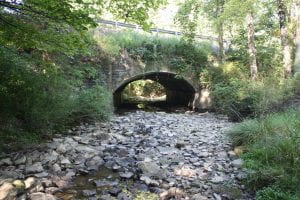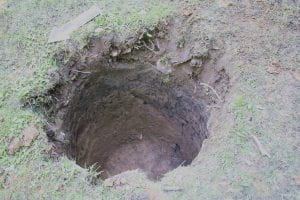Written by Gage Huey

Haymaker Run Bridge
The Rugh/Haymaker Mill Site (36WM1204) is a historic-period archaeological site located in Murrysville, Westmoreland County, Pennsylvania. This summer, four IUP Archaeology students in the Pennsylvania Highway Archaeological Survey Team (PHAST) recovered diagnostic artifacts from deposits associated with late 18th and early 19th century grist and sawmills that were constructed along Haymakers Run by two early Euro-American settlers, Michael Rugh and his son-in-law, Jacob Haymaker. These early mills used the water from Haymakers Run as a power source for the lumber saws and grinding stones. These mills are indicative of the kinds of early agricultural and industrial enterprises that settlers in this region developed to facilitate both longer and larger-term settlement of this region. Early maps of the region often focus on the industrial and extractive potentials of resources showing major rivers used for navigation, streams for mill placement, and indicating mineral rich for extraction.
This site was identified through a Phase I archaeological survey conducted by PHAST in order to comply with Section 106 of the National Historic Preservation Act (NHPA) of 1966. The NHPA requires federal agencies (and the state agencies like PennDOT who use funding from federal agencies) to take into account the ways that their undertakings may affect the archaeological resources both above and below the ground surface. The bridge where State Route 4041 crosses Haymakers Run is in need of replacement and because bridges and other transportation related infrastructure falls under PennDOT control, it also falls under NHPA regulations. In addition to replacement of the bridge structure itself, attention must be given to the construction activities and temporary access needs during construction (i.e. right of way, easements, drainage and erosion control measures, and/or temporary staging or runaround). The improvements may also affect archaeological resources, so cultural resource professionals (CRPs) must employ strategies to determine what may be affected by this undertaking.
In order to begin the Phase I investigation, background research was conducted using resources such as Pennsylvania’s Cultural Resource Geographic

Shovel Test Pit
Information Systems (CRGIS), soil surveys, topographic maps showing landforms, historical maps, and historic period aerial photographs. These sources help us understand what kinds of activities were or were likely happening in a particular area in the past. Once the likelihood of finding archaeological resources is assessed, CRPs visit the site to conduct a pedestrian survey. This field view helps CRPs identify areas of prior disturbance, which informs the development of a below-ground testing strategy. For this project, the excavation of five shovel test pits (STPs) was planned at a regular 15-meter interval to test the below-ground potential for intact archaeological deposits. This summer, the PHAST crew recovered a variety of historic artifacts through the course of excavation. The recovery of cultural material in the initial 5 STPs resulted in the need for additional testing to confirm the extent of these deposits. Each STP was dug according to Pennsylvania State Historic Preservation Office (PA SHPO) archaeological guidelines, with a diameter of 57 cm to a depth of 10 cm into sterile subsoil to test for all periods of human occupation on this landform. In total, 11 STPs were excavated, recovering 125 artifacts and contributing to the identification of the Rugh/Haymaker Mills site.
Of the 125 artifacts recovered, 69 could be attributed to a particular time period. These diagnostic artifacts included ceramic sherds, glass, animal bone, and a cut nail. The ceramics were analyzed by PennDOT Senior Archaeologist Angela Jaillet-Wentling who calculated a mean ceramic date of 1815. This date was re-calculated to 1817 based on the presence of olive-colored glass and a machine-cut nail. Accounting for a time lag between artifact manufacture and deposition, the material culture correlates well with the documentary evidence that the Rugh/Haymaker mills was constructed by 1809 and operated until at least 1875. Although the faunal remains from this site were not relevant to the dating of the deposits, the presence of a humerus from a domestic pig (Sus scrofa) certainly adds a depth of detail to the everyday lives of the settlers at the site. The fragmented humerus showed possible evidence of butchery which, along with other faunal remains found on the site, could provide important data to help improve our understanding of the type of foods early Euro-American settlers were raising and/or eating.
Overall, the archaeological resources encountered during the Phase I Survey resulted in the formal identification of the Rugh/Haymaker Mills Site. Because this potentially eligible site was located within the proposed project area for the bridge replacement, CRPs were tasked with making a choice for the future of this site: further investigation or avoidance. Thankfully, we were able to avoid additional investigation and impacts thanks to early site identification and flexible design. When the work for the Haymakers Run bridge replacement project begins, temporary construction fencing will be placed to protect the Rugh/Haymaker Mills site from any negative impacts that the bridge replacement may cause. This way, the intact archaeological deposits at the site can stay in situ; in other words, the cultural resources will stay where they are for the foreseeable future. This outcome is a best-case scenario because it allows for cooperation between the goals of archaeology and the Pennsylvania Department of Transportation (PennDOT). The proposed bridge replacement over Haymakers Run is able to go forward without major impediments or changes to the project and the undertaking will not negatively affect the archaeological resources associated with the Rugh/Haymaker Mills Site. At its best, Cultural Resource Management gives archaeologists a seat at the table when federally funded undertakings are planned in locations with potential for archaeological deposits. This is a great example of the things that can be accomplished through compliance with Section 106 of the NHPA.
You can read more about their summer here:(https://iblog.iup.edu/trowelsandtribulations/2020/09/25/phast-2020/)
Follow IUP Anthropology on Facebook, Twitter, and Instagram





